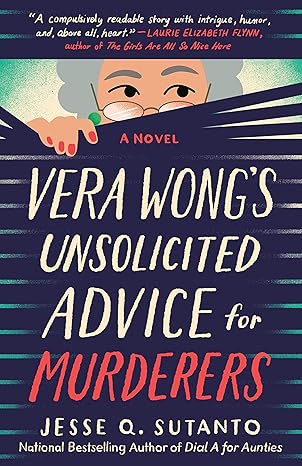Vera Wong’s Unsolicited Advice for Murderers by Jesse Q. Sutanto
Sixty-year-old Vera Wong springs out of bed at 4:30 a.m. each morning. “Late mornings, Vera believes, are only for toddlers and Europeans.” With her saucer sized visor, she race walks through San Francisco’s Chinatown scattering pigeons and pedestrians with abandon. When she returns to her home and business, Vera Wang’s World-Famous Teahouse (misrepresentation deliberate), she texts helpful advice to her long-suffering son. (“Don’t forget to look for girlfriend at office.”)
But despite her energy, Vera is bored. She misses her late husband, and customers are scarce at the teashop. Fortunately, one early morning, Vera finds a dead man on the floor of the shop. Not especially squeamish (or empathetic), Vera is thrilled. She is confident that she can solve the crime before the police, especially since she removes a key piece of evidence from the body. Now she waits for the killer to come back for it. Easy!
As Vera predicted, four young people appear in the shop over the next few days including the deceased’s widow and his twin brother. After plying the suspects with tasty Chinese cuisine, Vera worms her way into their lives. One of them may be the killer, but Vera finds them all “so agreeable” and in desperate need of Vera’s guidance. “Tch, young people nowadays, hopeless.”
Is the killer one of her new friends?
As a murder mystery, Vera Wong’s Unsolicited Advice for Murders is adequate only, but as a charming novel, it is first rate. The second novel, Vera Wong’s Guide to Snooping (on a Dead Man), features many of the same characters. It too is delightful if a bit too similar in plot.
